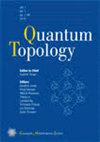A unification of the ADO and colored Jones polynomials of a knot
IF 1
2区 数学
Q1 MATHEMATICS
引用次数: 16
Abstract
In this paper we prove that the family of colored Jones polynomials of a knot in $S^3$ determines the family of ADO polynomials of this knot. More precisely, we construct a two variables knot invariant unifying both the ADO and the colored Jones polynomials. On one hand, the first variable $q$ can be evaluated at $2r$ roots of unity with $r \in \Bbb N^*$ and we obtain the ADO polynomial over the Alexander polynomial. On the other hand, the second variable $A$ evaluated at $A=q^n$ gives the colored Jones polynomials. From this, we exhibit a map sending, for any knot, the family of colored Jones polynomials to the family of ADO polynomials. As a direct application of this fact, we will prove that every ADO polynomial is q-holonomic and is annihilated by the same polynomials as of the colored Jones function. The construction of the unified invariant will use completions of rings and algebra. We will also show how to recover our invariant from Habiro's quantum $\mathfrak{sl}_2$ completion studied in arXiv:math/0605313.一个结的ADO和彩色琼斯多项式的统一
本文证明了$S^3$中一个结的有色琼斯多项式族决定了该结的ADO多项式族。更精确地说,我们构造了一个统一ADO多项式和有色琼斯多项式的双变量结不变量。一方面,第一个变量$q$可以在$r \in \Bbb N^*$的$2r$单位根处求值,得到了Alexander多项式上的ADO多项式。另一方面,第二个变量$A$在$A=q^n$处求值,给出了有色琼斯多项式。由此,我们展示了一个映射,对于任何结,彩色琼斯多项式族到ADO多项式族。作为这一事实的直接应用,我们将证明每个ADO多项式都是q完整的,并且被与有色琼斯函数相同的多项式所湮灭。统一不变量的构造将使用环和代数的补全。我们还将展示如何从arXiv:math/0605313中研究的Habiro量子$\mathfrak{sl}_2$补全中恢复我们的不变量。
本文章由计算机程序翻译,如有差异,请以英文原文为准。
求助全文
约1分钟内获得全文
求助全文
来源期刊

Quantum Topology
Mathematics-Geometry and Topology
CiteScore
1.80
自引率
9.10%
发文量
8
期刊介绍:
Quantum Topology is a peer reviewed journal dedicated to publishing original research articles, short communications, and surveys in quantum topology and related areas of mathematics. Topics covered include in particular:
Low-dimensional Topology
Knot Theory
Jones Polynomial and Khovanov Homology
Topological Quantum Field Theory
Quantum Groups and Hopf Algebras
Mapping Class Groups and Teichmüller space
Categorification
Braid Groups and Braided Categories
Fusion Categories
Subfactors and Planar Algebras
Contact and Symplectic Topology
Topological Methods in Physics.
 求助内容:
求助内容: 应助结果提醒方式:
应助结果提醒方式:


